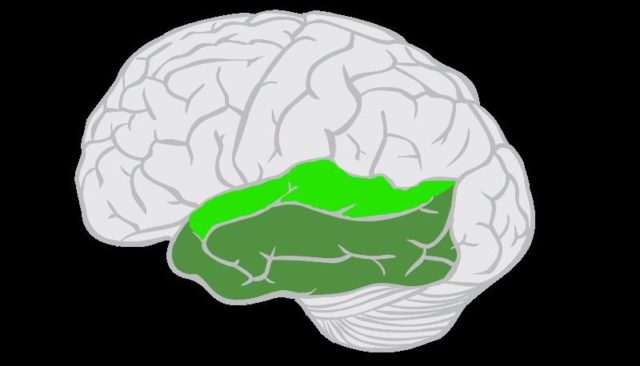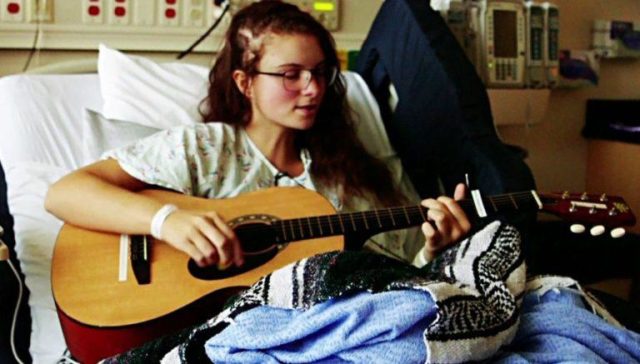Singin’ in the Brain: why brain tumour patients are singing on the operating table
Authors:
Zoë Firth & Priscila Borba Borges, students, European Master’s in Clinical Linguistics (EMCL+) and Adrià Rofes (advisor)
‘I can’t control my brain’. So sang Weezer in their 2001 hit ‘Island in the Sun’; how fitting, then, that this was the song teenager Kira Iaconetti chose to sing during her brain surgery. That’s right: during surgery. Kira was only 19 years old when she underwent brain surgery while awake in order to remove a tumour in her brain. Kira’s is the latest in a number of cases which have astounded both neurosurgery researchers and the world at large, due to the ingenious practice of having patients sing during their awake brain surgery.
Before her diagnosis, Kira Iaconetti was an avid singer with aspirations of becoming a performer. However, in what she described as a ‘cruel, sick joke’, Kira’s brain tumour was located in her right temporal lobe, an area heavily associated with our ability to make and listen to music (more on that below). The tumour, a low grade glioma, had resulted in a rare form of epilepsy called musicogenic epilepsy, which means that her seizures were induced specifically by listening to or performing music. Despite this, hope for Kira’s musical future was not lost; she had a team of doctors with a plan for removing the tumour without affecting her musical abilities. This plan involved a procedure called awake craniotomy, which involves opening the skull while the patient is under a powerful cocktail of anaesthetics.
The innovative feature of this procedure is the possibility of awakening the patient during the operation so that the surgical team can identify brain areas involved in critical functions, such as language and music. How? Well, if it is a singer like Kira who is on the operating table, she can be asked to sing a familiar song while an area of her brain is stimulated with electrical pulses. If the stimulation causes a systematic disruption in her singing (e.g. due to difficulties in articulation, or singing in key), then that area of the brain is deemed to be involved in her singing and should not be removed. A small tag is placed on that area to mark its involvement in singing, and the operation continues.
The tasks chosen for a patient to perform during awake brain surgery vary according to a number of factors, including what cognitive functions are at risk based on the tumour’s location and what the patient’s specific needs are. In Kira’s case, there was an extra challenge facing the team in charge of her operation: namely, to design musical tasks that would not trigger a seizure on the operating table. To achieve this, the surgical team worked closely with a musical therapist to design short tasks, such as listening tests and melody repetition, which could be administered during the operation while the team kept a close eye on Kira’s brain activity 1.
But musical performance in the operating room is not limited to singing; guitarist Robert Alvarez made headlines in 2018 for strumming his way through an awake craniotomy, and even piano players have tested their piano skills in the operation room – with a keyboard and all 2. In this way, the tasks which an individual performs in the operating room can be tailored to spare whatever musical ability the patient wants to keep, while making it so the natural growth of the tumour is arrested, giving the patient more and better years of life.
But are there any areas of the brain heavily involved in music, and do these areas differ from areas involved in, for example, language? In other words, does the representation of music and language dissociate in the brain? This question has long been of interest to researchers and musicians alike. Many studies have focused their attention on the auditory cortex, which is a composite of brain areas responsible for processing sounds, located on the left and right superior temporal gyri (the ‘bulges’ at the top of the temporal lobes; see Figure 1 below).

Specifically, it’s the right auditory cortex which accounts for many aspects of both listening to and producing music, for example rhythm and pitch 3 while interestingly enough, the left auditory cortex is more sensitive to speech (Leonard et al., 2018). Indeed, a neurosurgery team at Rochester University found that stimulating the right superior temporal gyrus disrupted a patient’s ability to repeat a melody, but not their ability to speak 4. Also, there is no more fitting example of this dissociation than the case of Russian composer Vissarion Shebalin, who, after suffering a stroke in his early 50s, retained his ability to write music despite extreme difficulties speaking and writing 5. Therefore, these studies show that music and language are to some extent processed separately in the brain.
Despite the potential for testing musical ability during awake brain surgery and the intrinsically compelling findings we can obtain, so far relatively little formal research has been conducted with this kind of testing. Some of the published results, though, are tremendously promising for patients as much as researchers. For example, for a professional opera singer in Rozzano, Italy, musical testing during surgery meant regaining performance on most musical tasks, and thus potentially returning to work for their own pleasure and continuing a life full of music 6.
The story had a similarly happy ending for Kira Iaconetti. Within days after her surgery, Kira was singing and playing guitar again (see Figure 2): the operation was a success.

And the good news didn’t stop there; after a clip of her singing during her operation went viral online, Weezer invited Kira to join them on stage at a concert this spring! As Nietzsche famously wrote, ‘life without music would be a mistake’ 7; thanks to the wonders of awake brain surgery, lives like Kira’s can instead be a huge hit.
References
- Kurs, L. (2018, November 8). Singing During Brain Surgery, Kira Performs to Preserve Her Passion. Seattle Children’s On the Pulse. ↩
- Leonard, M. K., Desai, M., Hungate, D., Cai, R., Singhal, N. S., Knowlton, R. C., & Chang, E. F. (2018). Direct cortical stimulation of inferior frontal cortex disrupts both speech and music production in highly trained musicians. Cognitive neuropsychology, 1-9. ↩
- Peretz, I., & Zatorre, R.J. (2005). Brain Organisation for Music Processing. Annual Review of Psychology, 56, 89-114. ↩
- Garcea, F. E., Chernoff, B. L., Diamond, B., Lewis, W., Sims, M. H., Tomlinson, S. B., Teghipco, A., Belkhir, R., Gannon, S. B., Erickson, S., Smith, S. O., Stone, J., Liu, L., Tollefson, T., Langfitt, J., Marvin, E., Pilcher, W. H., & Mahon, B. Z. (2017). Direct Electrical Stimulation in the Human Brain Disrupts Melody Processing. Current Biology, 27, 2684-2691. ↩
- Ruiz, E., & Montañés, P. (2005). Music and the brain: Gershwin and Shebalin. In Neurological Disorders in Famous Artists (Vol. 19, pp. 172-178). Karger Publishers. ↩
- Riva, M., Casarotti, A., Comi, A., Pessina, F., & Bello, L. (2016). Brain and Music: An Intraoperative Stimulation Mapping Study of a Professional Opera Singer. World Neurosurgery, 93,486e13-486e18. ↩
- Nietzsche, F. W., 1844-1900. (1998). Twilight of the idols, or, How to philosophize with a hammer. New York : Oxford University Press. ↩